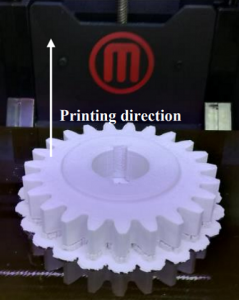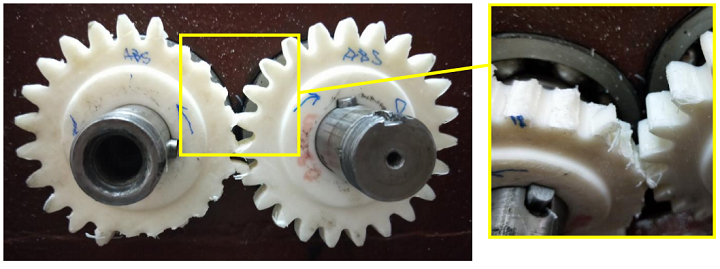Spur gears, which can achieve high transmission ratio and energy efficiency, are comment elements used in the transmission of motion and high intensity power for mechanical power drives, i.e. belt drives, chain drives, and cylindrical gear drives. These power transmission elements are exposed to non-conforming operating conditions in terms of load and speed, and are also applicable at high speeds. Spur gears play a big role in mechanical engineering, and are often tested in back to back gear test rigs in order to gain data regarding the gear teeth flanks’ surface load capacity.
A group of researchers from the University of Belgrade in Serbia and the Slovak University of Technology in Bratislava published a paper, titled “The Influence of Material on the Operational Characteristics of Spur Gears Manufactured by the 3D Printing Technology,” on their efforts to test plastic 3D printed spur gears on a back to back gear test rig, in order to increase the use of the technology in manufacturing these gears.
“In this paper the influence of the material type on the operational characteristics of spur gears manufactured by the 3D printing technology is analyzed, after the experimental testing performed on a back to back gear test rig, in the predefined laboratory conditions,” the researchers wrote.
“For the purposes of this paper, two types of polymeric materials were analyzed. The initial load in the form of a torque that was exposed to the spur gears was held constant, while the number of revolutions per minute of spur gears was varied. The plastic gears tested in this experiment operated in unlubricated working conditions.”
The researchers performed a comparative analysis, using commercially available PLA and ABS materials, on their impact on the 3D printed spur gears’ operating performance. The most common bulk failures in spur gears made of metal are teeth fractures and surface degradation like pitting and scuffing, but the researchers weren’t quite sure if this would be the case for their 3D printed plastic gears.
“With metallic spur gears, the load in the form of torque increases at the appropriate levels while simultaneously controlling the process of surface destruction of the gear teeth flanks,” the researchers explained.
“For the purposes of this experiment, the load in the form of a torque is fixed, that is, the initial moment of constant intensity has value 20 Nm. The torque of this intensity is insufficient to cause premature surface and volume destruction of spur gear teeth. The initially captured torque is “lost” during the wear process. The idea of this experiment was to estimate the wearing intensity for the initially captured load for two different spur gear materials.”
While back to back gear testing typically includes a constant number of revolutions of the electric motor, the frequency regulator was connected to the electric motor for this testing in order to have the ability to change the rotation. The researchers adopted a rotational speed change of 200 rpm, which was changed every ten minutes during the experiment, meaning they reached the maximum 1400 rpm after an hour of testing.
Indicators most commonly used for spur gear operational analysis include temperatures, noise and vibration levels, and the quantity and shape of wear products, and the researchers chose vibration (RMS acceleration) and temperature as the main indicators for their 3D printed ones. A thermal imaging camera was used to record the meshing temperature field of the 3D printed spur gears, while an SKF Microlog Analyzer GX collected information on the vibrations.
“Knowing the number of teeth of the tested spur gears, as well as their number of revolutions, a change in the amplitude of the vibration level is observed over time, by distinguishing the peak resulting from the meshing of the plastic spur gears,” the researchers explained.
In the first five minutes of the experiment under 200 rpm, there was hardly any vibration observed; additionally, in the first ten minutes under 200 rpm, the temperature of the PLA gears was about 20% higher than that of the ABS gears. Eventually, the 3D printed ABS spur gears endured roughly 30 minutes of work before experiencing failure in their teeth at 600 rpm, while the 3D printed PLA spur gears lasted for 90 minutes at 1400 rpm with no visible fractures, but showing “evident teeth contact surface destruction.”
“In the interval from 5 to 15 minutes, vibrations behaviour of ABS and PLA plastic gear pairs is inverse comparing to their thermal behaviour,” the researchers wrote. “The vibrations of ABS plastic gears is higher (RMS=0,18 ms-2) than the ones made of PLA plastic (RMS=0,06 ms-2). Increasing the rotational speed from 300 up the 400 rpm, the vibration of both gear pairs significantly rises (up to RMS=0,72 ms-2). After 400 to 500 and 600 rpm, the vibration levels are declining. After 30 minutes of testing with 600 rpm, just before tooth of ABS gear pair fractured, the level of RMS accelerations was 0,3 ms-2. The vibration level of PLA plastic gear pair vary with an increase of rpm and oscillate around 0,25 ms-2. At the end of experiment (on 1400 rpm) the vibration values of PLA plastic gear pair is increasing to 0,5 ms-2, probably due to gear tooth contact surface destruction.”
Based on their findings, the researchers were able to conclude that the 3D printed PLA spur gears had better operational characteristics than the ABS ones.
Co-authors of the paper are Aleksandar Dimić, Žarko Mišković, Radivoje Mitrović, Mileta Ristivojević, Zoran Stamenić, Ján Danko, Jozef Bucha, and Tomáš Milesich.
Discuss this research and other 3D printing topics at 3DPrintBoard.com or share your thoughts below.
Subscribe to Our Email Newsletter
Stay up-to-date on all the latest news from the 3D printing industry and receive information and offers from third party vendors.
You May Also Like
3DPOD Episode 198: High Speed Sintering with Neil Hopkinson, VP of AM at Stratasys
Neil Hopkinson, a pioneering 3D printing researcher, played a pivotal role in developing a body of research that is widely utilized today. He also invented High Speed Sintering (HSS), also...
GE Additive Transforms into Colibrium Additive in New Brand Move
One of the largest and most compelling companies in the 3D printing industry, GE Additive, has undergone a rebrand. Now, known as Colibrium Additive, the company and its new name...
HP & INDO-MIM Collaborate to Boost Metal 3D Printing in India
HP Inc. and INDO-MIM, a US- and India-based supplier of metal injection molding (MIM) powders and contract manufacturer, have announced that the two companies will collaborate to accelerate additive manufacturing...
Nylon 3D Printed Parts Made More Functional with Coatings & Colors
Parts 3D printed from polyamide (PA, Nylon) 12 using powder bed fusion (PBF) are a mainstay in the additive manufacturing (AM) industry. While post-finishing processes have improved the porosity of...



































